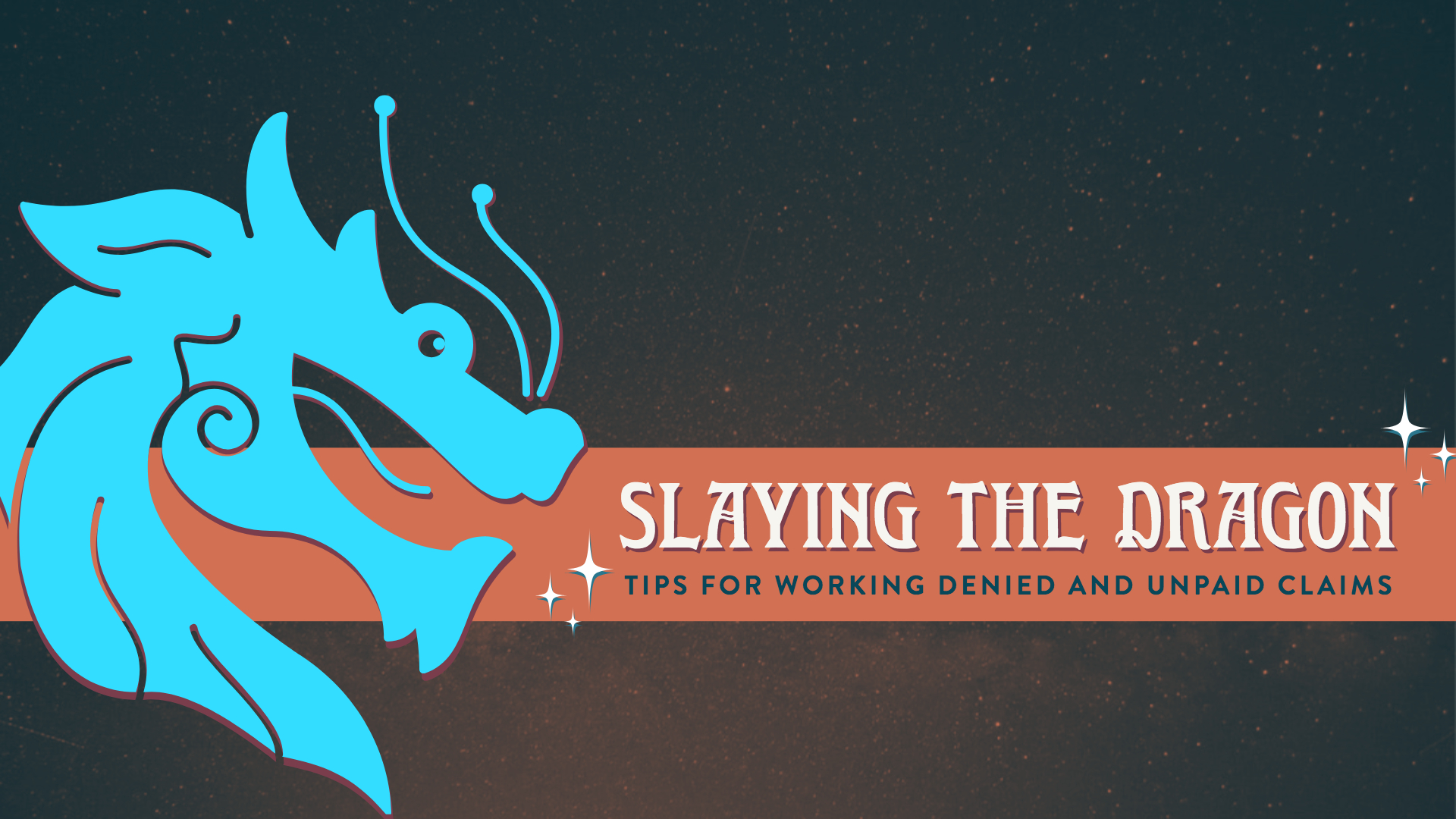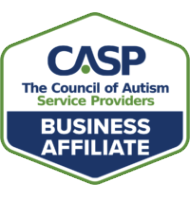Written by: Megan Lawhon
In a small village, a knight sits lazily enjoying a tankard of ale. All at once, the village bells start ringing signaling that the village is in some kind or peril. Immediately, the knight goes to his room. He reviews his armor and organizes his weapons lovingly. This task complete, he reviews all the information he can get his hands on regarding the upcoming threat. As he races out of the tavern, his mind begins formulating a battle plan. This dragon is large and angry, yet this doesn’t even cross his mind. He has fought dragons before and won with his trusted squire at his side. He yells for his squire to join him quickly and walks to the hill to meet the threat head-on.
You, as a billing agent, are this same “knight” protecting a village of providers, subscribers, and clients. The “dragon” you are facing represents the denials and unpaid claims that we all must face. Like this knight in the parable, we must go through specific steps before we can “fight” the dragons we face.
Get Organized
The first step necessary under any circumstance is to get organized. If there is a mountain of paperwork to go through, organize it as best fits the circumstances. While sorting through the paperwork, make certain that you have a system that allows you to grab the documents when they are needed. Some people prefer to use hard copies of paper, in which case, you may want to put all the information for a client in one folder. This will allow you to keep all the information together while at the same time following HIPAA laws and protecting the client’s information from prying eyes. Other people prefer to keep all the information stored electronically. In this case, you want to open all the necessary documents to work on any denial for that client. Whatever method you chose you must be thorough and efficient.
You will also want a system that allows you to set reminders for yourself. Reminders keep you from forgetting claims or allowing them to sit longer than they should. This could be as simple as writing reminders down on a calendar or some more detailed system. Just make sure that it’s a consistent system every time.
Finally, it’s necessary to keep your “squire” informed of all your activities. In this instance, the squire represents your notes. Every time you work on a patient’s account you MUST take notes. Therefore, you will need a way to not only organize your notes, but also to both review and add additional information. It is a good idea that these notes also include all the information necessary to call a representative. This could be something as simple as an excel spreadsheet, but the idea is to have your squire ready to hand you “weapons” at any given time.
Sample Note:
Client: Smith, John
DOB: 1/1/1920
Funder: BCBS
Member ID: MEG24135211
Claim #2019K49759A
Date of Service: 3/18/18
Denial: Code CO197–precertification / authorization / notification absent
Gather All Information
In the previous step, I suggested that you keep all the client information in one place. There are a few things that will be required on every call you make to a provider representative. You will need to have the client’s first and last name, the claim number or ICN, and any denial reason you have. There are times when you are missing a claim number or a denial reason. In these instances, it is best to check a provider portal or call the insurance for the information.
In this second step, you are gathering your armor and weapons. For example, if a funder denies a claim for no authorization for the service, you will start looking for evidence that an authorization exists. Most of the time, these are easy to find and are often already in the funder’s system. However, at times when you can’t find any information, you may want to contact the provider or check the provider portal for any auth information they can supply.
This step also includes receiving and reviewing the regulations and requirements of the funder you are working with. Knowing how the “dragon” thinks will allow you to fight the denial more efficiently. An example of this is a claim denied and the funder is asking for additional medical documentation to prove that the service was necessary. Some funders prefer you send this information inside the provider’s portal, other funders prefer the information faxed in to the claim’s department, and still other funders ask that you mail the information to them. It is essential that you do the research to find out how denials are to be handled. This will save you time and struggle later down the road.
As always, you must take notes on anything you find. The more information you put into your notes the fewer mistakes you will make and the clearer your understanding of the issue will be.
Sample Note:
Client: Smith, John
DOB: 1/1/1920
Funder: BCBS
Member ID: MEG24135211
Claim #2019K49759A
Date of Service: 3/18/18
Denial: Code CO197–precertification / authorization / notification absent
Notes: Authorization on file, auth #QUR897P. If auth not in funder system, send auth via provider portal.
Make a Battle Plan
In this step, you bring all your information together and set up the battlefield. Like a game of chess, you want to come up with a strategy for dealing with any and all objections the funder may have to any corrected or reprocessed claims.
If you have already faced a denial, you will more than likely already have a battle plan in place and can quickly come up with a strategy. If you have not faced this type of denial, you will want to have any and all information you can close by.
For example, if a claim gets denied as not being medically necessary, you will need to have proof to show how necessary the service really is. You will need to gather all the authorizations that cover the dates of service in question, check provider portal for any additional information you can find on this claim (such as check numbers etc.), and ask questions from fellow employees who may have more experience than you.
This step also requires that you, as the billing agent, go back and check the original billing for errors. Make sure that the provider name is correct and that you have billed the service according to the provider’s contract with the funder.
It is imperative at this stage that all the information you have found that even hints at being related to this claim, goes into your notes for your squire. These weapons may not be necessary, but they are good to have in your arsenal.
Sample Note:
Client: Smith, John
DOB: 1/1/1920
Funder: BCBS
Member ID: MEG24135211
Claim #2019K49759A
Date of Service: 3/18/18
Denial: Code CO197–precertification / authorization / notification absent
Notes: Authorization on file, auth #QUR897P. If auth not in funder system, send auth via provider portal. – auth covers codes H0032 (12units) & H0031 (12 units) for dates of service 1/1/2018-6/1/2018.
Face the Dragon
This phase does not always require that you interact with a funder representative. Sometimes, it is as simple as sending a corrected claim or sending additional medical documents via the requested method. When you do have to call a funder representative, be sure to have your squire close. Your squire will have all the weapons you could need in the form of your notes. Be sure to have all available resources close by while making a call.
Before making a call, gather your thoughts and think about a clear way to communicate your issue. When you do make a call, it is best to use the following tips:
- Ask for and be sure to speak to a claims representative in the correct department (medical, dental, behavioral health etc.)
- State the reason for your call and clearly explain the situation.
- Listen to the claims representative fully before adding any information or asking questions.
- Be sure you are discussing the same claim, verify the dates of service, and verify the total charge amount on EOB.
- Use your squire’s notes and any material available to you.
- Always be courteous, patient, and kind—even when stressed or pushed to your limit
- Look out for the red flags. If you feel the information is not accurate or not getting anywhere then ask for a supervisor or hang up and call back for another rep.
- In your notes, track the time of the call, the representative you spoke to, and the reference number.
Sample Note:
Client: Smith, John
DOB: 1/1/1920
Funder: BCBS
Member ID: MEG24135211
Claim #2019K49759A
Date of Service: 3/18/18
Denial: Code CO197–precertification / authorization / notification absent
Notes: Authorization on file, auth #QUR897P. If auth not in funder system, send auth via provider portal- auth covers codes H0032 (12units) & H0031 (12 unites) for dates of service 1/1/2018-6/1/2018. – 4/15/19 Rep: Tasha sees that the authorization is on file. Has sent claim internally for reprocessing. Ref# AV208K00096.
When the Battle Gets Intense
Many times, you may feel as though you aren’t getting anywhere with the claim. When this happens, it is best to go back to square one and review all of your current information regarding this claim. Sometimes, we overlook things that can be critical in getting claims paid or we have misunderstood the denial reason. You may even want to call a representative regarding the claim as if it is the first time you are calling. This may get you more helpful and appropriate information. Any action you take MUST go into your notes.
Some situations can be even more distressful, and you may need to file an appeal. As a billing specialist, you will want to file an appeal as quickly as possible (generally after the second or third denial of the claim). You will need to again gather all your information (authorizations, diagnosis, session notes, account notes, remits, etc.) and your squire, in order to write up a clear, concise appeal and send the supporting documents.
Each funder has a specific method for appeal. You will want to research how an appeal is to be written for the funder in question and follow it to the letter. You will need to let the provider know that you are sending an appeal. Sharing this information with a provider may prove beneficial because it provides you with an ally and potentially additional information you can add to your appeal.
Once an appeal is sent, DO NOT FORGET ABOUT IT! It is imperative that the billing specialist calls to make sure the appeal has arrived. When it can be confirmed that the appeal is in the funder’s hands, the specialist will want to call for status updates every 30, 60, and 90 days until a determination has taken place. If an appeal hasn’t finished processing after 90 days, it is your job to find out why it is still under review and to have it escalated if need be.
Sample Note:
Client: Smith, John
DOB: 1/1/1920
Funder: BCBS
Member ID: MEG24135211
Claim #2019K49759A
Date of Service: 3/18/18
Denial: Code CO197–precertification / authorization / notification absent
Notes: Authorization on file, auth #QUR897P. If auth not in funder system, send auth via provider portal- auth covers codes H0032 (12units) & H0031 (12 unites) for dates of service 1/1/2018-6/1/2018 – 4/15/19 Rep: Tasha sees that the authorization is on file. Has sent claim internally for reprocessing. Ref# AV208K00096. – 5/18/19 Rep: Kyle says that the reprocessed claim has been denied because we are out units for H0032. Reviewed units used and this is incorrect. – 5/20/18 Appeal written and sent via provider portal – 5/30/18 Confirmed appeal has arrived and is under review. 6/30/18 – Appeal has been under review for 30 days, still in process. 7/29/2018 – Appeal has been finalized. Payment will appear on Check #1TR5587420 for $480.42.
At the End of the Day
As mentioned before, sometimes the battle is quick and the claims get paid without much of a struggle. In these cases, the knight can pat himself on the back and go back to the village he protects. Other times, the battle will end in a draw and there is nothing more that you, as the billing specialist, can do about it. In this case, an additional appeal may need to be filed by the patient rather than the provider.
There will also be dark days, when the dragon defeats the knight and there is absolutely nothing that can be done about it. In this case, learn from your mistakes. Dust yourself off and come back prepared for the next threat to your village.
No matter how the day ends, if you follow the knight’s example (getting organized, gathering all information, coming up with a battle plan, and relying heavily on your squire) you know you have done all you can.
Of course, if you have any questions about how we can help in the way that benefits your agency the most, call us at (520) 800-4740 or use our contact or prospective client forms today.
About Our Presenters

Megan Lawhon
Revenue Specialist and huge nerd. I enjoy allowing my imagination to flow. I love taking that imagination and applying it to real-life examples to assist others. I feel best when my own experiences and understanding of the world can help others in their own struggles. Favorite quote: “Fairytales do not tell children the dragons exist. Fairytales tell children the dragons can be killed”- G.K. Chesterton





